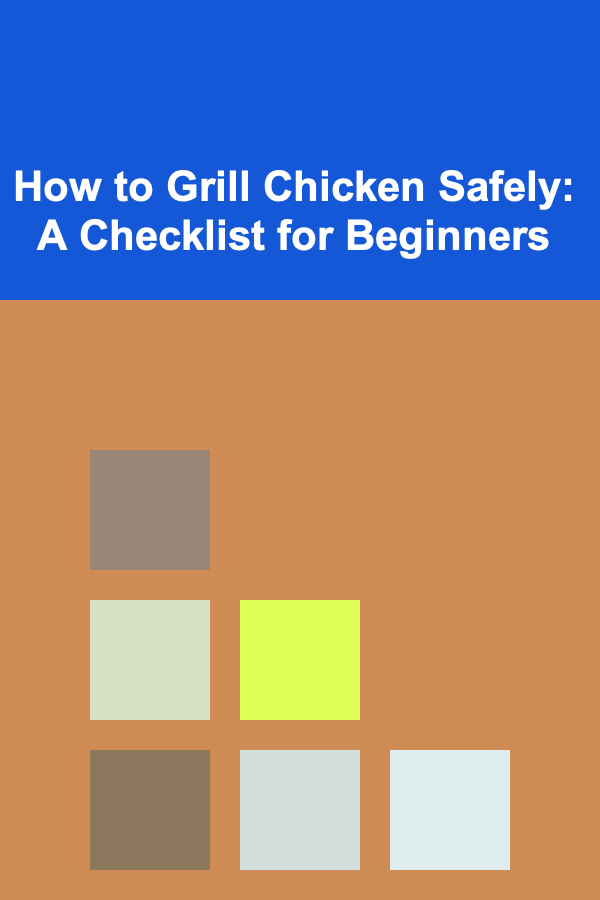
How to Grill Chicken Safely: A Checklist for Beginners
ebook include PDF & Audio bundle (Micro Guide)
$12.99$9.99
Limited Time Offer! Order within the next:

Grilling chicken can be a fun and delicious way to prepare a meal, whether it's for a summer barbecue, a family gathering, or a weekend cookout. However, it also comes with the responsibility of ensuring that the food is cooked safely, especially since chicken is one of the most common sources of foodborne illnesses. Undercooked chicken can harbor harmful bacteria such as Salmonella and Campylobacter, which can lead to serious food poisoning. Therefore, it's crucial to follow proper grilling techniques to ensure that the chicken is not only flavorful but also safe to eat.
If you're a beginner at grilling, the process can seem overwhelming at first. With so many factors to consider---from the type of grill to the grilling temperature and cooking time---it's easy to get lost in the details. But don't worry! By following a simple checklist, you can set yourself up for success and grill chicken safely every time. This article will guide you step-by-step through the essential safety practices and tips to grill chicken to perfection.
Choosing the Right Chicken
The first step in grilling chicken safely is selecting the right chicken for your recipe. While the type of chicken cut you choose can affect the cooking time and flavor, the safety of the meat depends largely on its freshness and handling. Here's what you should consider when purchasing chicken:
-
Purchase Fresh or Frozen Chicken from a Reliable Source: Always buy chicken from a reputable butcher, grocery store, or supplier. Check the expiration date if you're buying pre-packaged chicken. If you're buying frozen chicken, ensure that it hasn't thawed and refrozen during transportation or storage, as this can compromise its safety.
-
Check for Freshness: Fresh chicken should have a pinkish hue and should not have any unpleasant odor. If the chicken appears gray or has a foul smell, it's best not to buy it.
-
Decide on Cuts: Chicken comes in various cuts: whole chicken, breasts, thighs, wings, and drumsticks. Each cut requires different grilling techniques, and some cuts take longer to cook than others. For beginners, it's often easiest to start with chicken breasts or thighs, as they cook relatively quickly and are forgiving if slightly overcooked.
Thawing Chicken Safely
If you're grilling frozen chicken, it's crucial to thaw it properly before grilling. Thawing chicken at room temperature can lead to bacterial growth, so always use one of the following methods to thaw the chicken safely:
-
In the Refrigerator: The safest way to thaw chicken is by placing it in the refrigerator. Depending on the size of the chicken or cut, this may take several hours or overnight. This method ensures that the chicken stays at a safe temperature (below 40°F or 4°C) during the thawing process.
-
In Cold Water: If you're short on time, you can thaw chicken in cold water. Place the chicken in a leak-proof plastic bag to prevent water from getting inside, and submerge it in cold water. Change the water every 30 minutes, and cook the chicken immediately after thawing.
-
In the Microwave: You can also thaw chicken in the microwave, but it's essential to cook it immediately after thawing, as some areas of the chicken may start to cook during this process, which can encourage bacterial growth.
Never thaw chicken at room temperature or in hot water, as this can allow bacteria to grow rapidly.
Preparing the Grill
Properly preparing your grill is key to grilling chicken safely. Whether you're using a gas grill, charcoal grill, or an electric grill, make sure it's clean and set up for even heat distribution. Here are some key preparation steps:
-
Clean the Grill Grates: Before grilling, scrub the grill grates with a wire brush to remove any leftover food, grease, or bacteria. Cleaning the grill not only ensures a safe cooking surface but also prevents the chicken from sticking to the grates.
-
Preheat the Grill: Preheating the grill helps to achieve an even cooking temperature. For gas grills, set the heat to medium-high, and for charcoal grills, allow the coals to burn down to an even, ashy layer. A properly preheated grill ensures that the chicken cooks evenly and safely.
-
Set Up Two Heat Zones (for Charcoal Grills): If you're using a charcoal grill, create two heat zones: one for direct heat (high heat) and one for indirect heat (lower heat). The direct heat zone is where you will sear the chicken to lock in flavors, while the indirect heat zone is used for slower cooking to ensure the chicken reaches a safe internal temperature.
Marinating and Seasoning Chicken
While marinating and seasoning chicken is not directly related to food safety, it can enhance the flavor of your grilled chicken. Follow these steps to marinate chicken safely:
-
Use the Refrigerator for Marinating: Always marinate chicken in the refrigerator, not at room temperature. Bacteria can multiply rapidly at room temperature, so never leave marinating chicken outside of the fridge for more than two hours.
-
Avoid Cross-Contamination: If you're using a marinade, ensure that you don't reuse it to baste the chicken unless you bring it to a boil first to kill any harmful bacteria. Similarly, keep raw chicken and its marinade separate from other foods, especially ready-to-eat items like vegetables or salads.
-
Seasoning Tips: Season the chicken with your choice of herbs, spices, or sauces. Whether you prefer a simple salt-and-pepper seasoning or a complex barbecue rub, make sure that the seasoning is spread evenly to enhance flavor.
Checking the Grill Temperature
Proper temperature management is one of the most critical factors in grilling chicken safely. The USDA recommends cooking chicken to an internal temperature of 165°F (74°C) to ensure it's safe to eat. However, there are additional considerations to keep in mind:
-
Use a Meat Thermometer: Invest in a reliable food thermometer to measure the internal temperature of your chicken. Insert the thermometer into the thickest part of the chicken, avoiding bone or fat, as these can provide inaccurate readings. Check the temperature of the chicken periodically to ensure it reaches the safe minimum temperature.
-
Monitor Grill Temperature: For gas and charcoal grills, keep an eye on the grill temperature. You should aim for a consistent temperature between 350°F and 450°F (175°C to 230°C) for most cuts of chicken. If the temperature gets too high, the chicken may burn on the outside while remaining raw inside.
-
Use Indirect Heat for Thick Cuts: For thick cuts like bone-in chicken breasts or whole chicken, use indirect heat to ensure the chicken cooks all the way through without burning the exterior. This method may take longer but is crucial for ensuring food safety.
Grilling the Chicken
Now that your grill is prepared and your chicken is seasoned, it's time to grill! Follow these tips for cooking chicken to perfection:
-
Place the Chicken on the Grill: Arrange the chicken pieces on the grill, spacing them out to allow heat to circulate. Avoid overcrowding the grill, as this can cause uneven cooking.
-
Sear the Chicken: If you're using a gas or charcoal grill, sear the chicken over direct heat to create a flavorful crust. Searing also helps to lock in moisture. Depending on the size and cut, sear each side for 3-5 minutes before moving the chicken to the indirect heat zone to finish cooking.
-
Flip the Chicken Sparingly: Try to flip the chicken only once or twice during grilling to avoid disrupting the cooking process. Constant flipping can cause the chicken to dry out and affect the overall texture.
-
Check for Doneness: Use your meat thermometer to check the internal temperature of the chicken. Once the thermometer reads 165°F (74°C), the chicken is fully cooked. If you don't have a thermometer, you can check for clear juices and a firm texture, but a thermometer is the most accurate method.
Resting the Chicken
After grilling, it's important to let the chicken rest for a few minutes before serving. Resting allows the juices to redistribute throughout the meat, ensuring a moist and flavorful result. Avoid cutting into the chicken immediately after grilling, as this can cause the juices to escape, leading to dry meat.
- Let the Chicken Rest for 5-10 Minutes: Remove the chicken from the grill and place it on a clean plate or cutting board. Cover it loosely with aluminum foil and let it rest for at least 5-10 minutes before serving.
Cleaning Up After Grilling
After you've enjoyed your grilled chicken, don't forget about proper cleanup to ensure food safety for your next grilling session:
-
Clean the Grill Grates: Once the grill has cooled down, clean the grates again with a wire brush to remove any leftover food particles or grease. This prevents cross-contamination and keeps your grill in good condition.
-
Wash Your Hands: Always wash your hands thoroughly with soap and water after handling raw chicken, utensils, or plates that have come into contact with raw chicken.
-
Sanitize Your Utensils and Surfaces: Wash cutting boards, tongs, and meat thermometers with hot, soapy water to remove any bacteria from the raw chicken. It's also a good idea to sanitize your kitchen surfaces after preparing the chicken.
Conclusion
Grilling chicken safely is essential for ensuring that your meal is not only delicious but also free from harmful bacteria. By following this checklist---starting with choosing the right chicken, thawing it properly, and preparing the grill to monitoring cooking temperatures---you can avoid foodborne illnesses and enjoy perfectly grilled chicken every time. Remember, food safety is just as important as flavor when it comes to grilling, and by keeping these tips in mind, you can grill with confidence and peace of mind. Happy grilling!
Reading More From Our Other Websites
- [Organization Tip 101] How to Use a Trolley for Mobile Music Supplies
- [Personal Investment 101] How to Invest in Your Own Business When You're Broke
- [Organization Tip 101] How to Use Shelving Units to Maximize Sewing Room Space
- [Home Storage Solution 101] How to Store Sports Equipment Effectively
- [Personal Care Tips 101] How to Incorporate Dry Shampoo Into Your Travel Skincare Kit
- [Organization Tip 101] How to Store Bulk Items Effectively in Your Pantry
- [Organization Tip 101] How to Organize Medical Records for Easy Access
- [Personal Finance Management 101] How to Start a Side Hustle to Increase Your Monthly Income
- [Weaving Tip 101] Weaving with Color: How to Design Bold Patterns for Home Décor
- [Organization Tip 101] How to Use Furniture to Enhance Acoustic Comfort

How to Organize Your Equipment for Team Practices
Read More
How to Sell Handmade Furniture on Facebook Marketplace: A Step-by-Step Guide
Read More
How to Understand and Invest in Index Funds for Passive Income
Read More
How to Use Mirrors to Make Small Rooms Feel More Spacious
Read More
Maximizing Earnings with Deep Learning-Based Automation
Read More
How to Maintain a Healthy Eating Lifestyle Long-Term
Read MoreOther Products

How to Organize Your Equipment for Team Practices
Read More
How to Sell Handmade Furniture on Facebook Marketplace: A Step-by-Step Guide
Read More
How to Understand and Invest in Index Funds for Passive Income
Read More
How to Use Mirrors to Make Small Rooms Feel More Spacious
Read More
Maximizing Earnings with Deep Learning-Based Automation
Read More